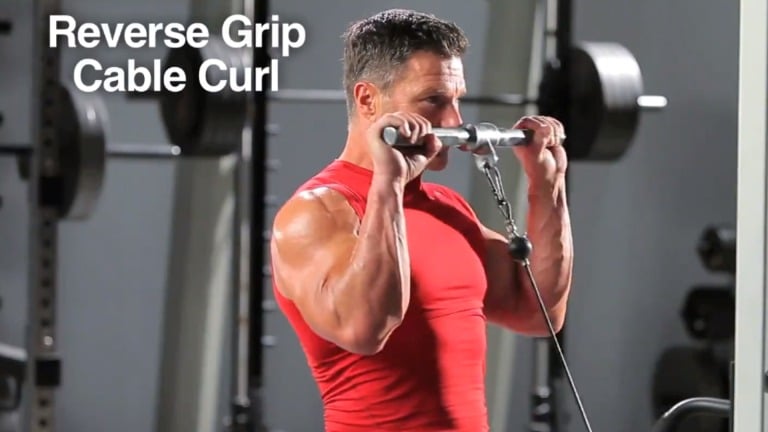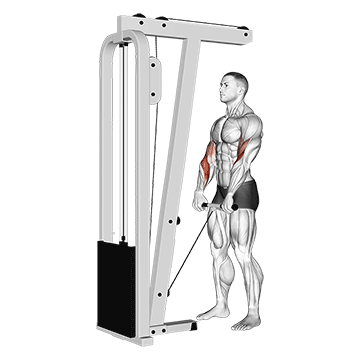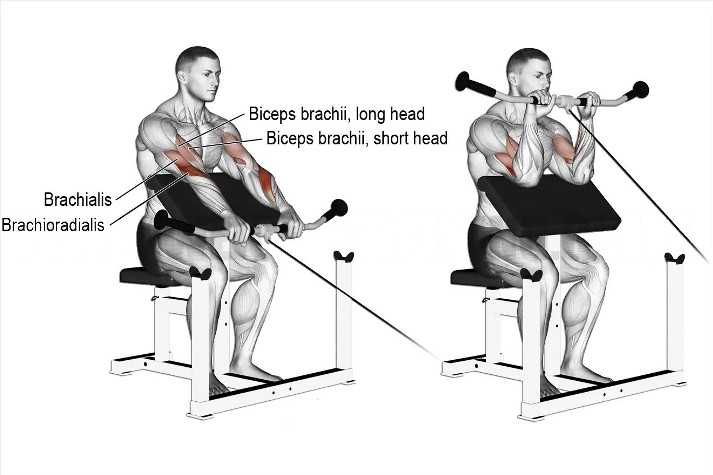Reverse bicep curls can be your secret weapon in your quest to build bigger arms. The cable reverse curl is a variation of the standard cable biceps curl, in which you hold the Bar with your palms facing down (overhead grip).
The reverse cable curl is great for building both the bicep and brachialis (upper arms) and the brachioradialis (lower arm) muscles.
The cable provides a greater range of motion and constant tension on the biceps throughout the curl. You can do it as part of a full-body or targeted arm workout.
This exercise is commonly used to strengthen the forearms, improve grip strength, and contribute to a more balanced arm development.
Know More: Bicep Cable Workout To Build Mass And Strength

- Cable Reverse Curl Muscles Worked
- How To Do Cable Reverse Curl
- Proper Form And Techniques
- Reverse Grip Cable Curls Variations
- 1. Single Arm Reverse Cable Curl
- 2. Wide-Grip Reverse Cable Curl
- 3. Close Grip Reverse Cable Curl
- 4. Reverse Grip Cable Preacher Curl
- Add Cable Reverse Curl Into Your Workout Routine
- 1. Bicep-Focused Workout Routine
- 2. Pull Workout Routine
- FAQs
- What muscles do reverse grip cable curls work?
- Is reverse cable curl good?
- Is reverse curl better than curl?
Cable Reverse Curl Muscles Worked
- The cable reverse curl primarily targets the muscles in the forearm, specifically the brachioradialis.
- Additionally, other muscles come into play as secondary stabilizers during the reveres grip cable curl: Biceps Brachii, Brachialis,
- Some other muscles worked or played stabilizer roles, including wrist Extensors, flexors, and core muscles. The deltoids and trapezius muscles are also active, but only for stabilization.
Use Our Free Calculator To Know Your Calories Requirement To Gain Muscle Mass
How To Do Cable Reverse Curl
- Stand facing a cable machine with your feet shoulder-width apart.
- Hold a bar attachment that is attached to a low pulley using a pronated grip (palms down).
- Your hands should be shoulder-width apart or slightly narrower, depending on your comfort.
- Keep your core engaged and maintain a slight bend in your knees.
- Keep your elbows in close to your sides and slowly curl the weight up towards your chest.
- Pause at the top of the contraction
- Then, slowly lower the weight back down to the starting position.
- Repeat 3-4 sets of 8–12 repetitions with proper form.
Proper Form And Techniques
- Do not use jerking motions to lift the weight. This can cause injury and reduce the exercise’s effectiveness.
- Pause at the top of the movement and squeeze your biceps and brachialis muscles.
- Do a slow, controlled descent, as it will increase the time under tension and improve the effectiveness of sets.
- Keep your elbows close to your sides and don’t move forward or outward.
- Keep your back and neck straight, and avoid excessive leaning or arching.
- Do a full range of motion, letting your arms fully contract at the top and fully extend at the bottom.
- Incorporate proper warm-ups, rest, and nutrition into your exercise program.
- Rest for 24 to 48 hours before training the same muscle groups to allow sufficient recovery.
- Choose a weight that allows you to complete 8–12 reps with proper form.
- Don’t go heavy. Choose a medium weight and focus on perfecting your form.
- The number of reps you should do depends on your goals, whether to increase strength or build muscle mass and endurance. For muscle growth, it is best to do for around 6–12 reps per set. For muscle endurance: do 15-20+ reps per set.
| Level | Sets | Reps | Frequency |
|---|---|---|---|
| Beginner | 2-3 | 8-12 | 1-2 times per week |
| Intermediate | 3-4 | 8-12 | 2-3 times per week |
| Advanced | 4-5 | 8-15 | 2-3 times per week |
Reverse Grip Cable Curls Variations
There are many variations of reverse grip cable curl that you can add to your workout routine, and each has its own unique benefits.
Here are the 4 best variations of reverse curls that can target different areas of your biceps and forearms.
1. Single Arm Reverse Cable Curl
The single-arm reverse cable curl focuses on one arm at a time. This variation provides a more concentrated and unilateral workout.
The exercise’s unilateral nature encourages muscle activation in the targeted forearm and upper arm muscles.
Since you work one arm at a time, the single-arm reverse cable curl helps you identify and correct any strength or muscle imbalances between your arms.

2. Wide-Grip Reverse Cable Curl
In this version, you grip the handle or bar attachment wider than shoulder-width apart.
Like other reverse curl variations, the wide grip also engages the brachioradialis muscle in your forearms. Still, it also emphasize the short head bicep and give your biceps more width.
Adding a wide-grip reverse cable curl to your routine will give the muscles a different stimulus than standard-width grips.
3. Close Grip Reverse Cable Curl
Close-grip reverse cable curls are a variation of the reverse cable curl exercise that involves using a narrow grip on the cable attachment (Narrower than shoulder-width apart).
This variation modifies muscle engagement and emphasizes certain parts of the forearm and upper arm muscles.
A narrow grip will emphasize the long head and build the peak of your biceps.

4. Reverse Grip Cable Preacher Curl
If you’re looking for one more effective reverse curl exercise, try the cable reverse grip preacher curl.
The preacher’s curl bench provides support, minimizing cheating and swinging, which can be common with other bicep exercises. This helps you keep your form tight and target your muscles effectively.
The reverse grip preacher curl can provide a unique stimulus, helping you overcome plateaus and enhance your training.

Related Post: Cable Arm Exercises To Build Bigger Biceps And Triceps
Add Cable Reverse Curl Into Your Workout Routine
The reverse cable curls can be incorporated into your workout routine in various ways. Here are some options:
- As a standalone exercise: Do on 3–4 sets of 8–12 reps.
- As part of a bicep workout, Do 3–4 sets of 8–12 reps along with other bicep exercises, such as the barbell bicep curl and hammer curl.
- As part of a full-body workout: Do 3–4 sets of 8–12 reps and other compound exercises like squats, deadlifts, and bench presses.
1. Bicep-Focused Workout Routine
| Exercise | Sets | Reps |
|---|---|---|
| Dumbbell Curl | 3-4 | 8-12 |
| Hammer Curl | 3 | 10-12 |
| Preacher Curl | 3 | 8-10 |
| Cable Reverse Curl | 4 | 8-12 |
| Cable Curl | 3 | 8-12 |
2. Pull Workout Routine
| Exercise | Sets | Reps |
|---|---|---|
| Pull-Ups | 3 | 8-10 |
| Barbell Upright Row | 3 | 8-12 |
| Lats Pulldowns | 3 | 10-12 |
| Barbell Curl | 3 | 8-12 |
| Dumbbell Reverse Curl | 3 | 8-12 |
FAQs
What muscles do reverse grip cable curls work?
Reverse grip cable curls work the brachialis, brachioradialis, biceps, and forearm muscles.
Is reverse cable curl good?
Yes, the reverse cable curl is an excellent biceps exercise. The primary benefits are:
- Isolates biceps through a full range of motion
- Keeps constant tension on the biceps due to cable resistance
- Reduces strain on wrists compared to standard curls
- It allows you to focus on bicep peak contraction.
- It can be done unilaterally to correct muscle imbalances
- Provides biceps shape and definition when done properly
Is reverse curl better than curl?
Reverse curls and regular curls are both good exercises for building muscle mass in your biceps and forearm. Regular curls are a good option if you want to build muscle mass in your biceps. However, if you are specifically looking to target the brachialis and forearm muscle, then reverse curls are a better option.
References:
- Oliveira LF, Matta TT, Alves DS, Garcia MAC, Vieira TMM. Effect of the shoulder position on the biceps brachii EMG in different dumbbell curls. Journal of Sports Science & Medicine.
- Barakat C, Barroso R, Alvarez M, Rauch J, Miller N, Bou-Sliman A, De Souza EO. The Effects of Varying Glenohumeral Joint Angle on Acute Volume Load, Muscle Activation, Swelling, and Echo-Intensity on the Biceps Brachii in Resistance-Trained Individuals. Sports (Basel). 2019 Sep 4;7(9):204. doi: 10.3390/sports7090204. PMID: 31487841; PMCID: PMC6783981.

Manish is a NASM-certified fitness and nutrition coach with over 10 years of experience in weight lifting and fat loss fitness coaching. He specializes in gym-based training and has a lot of knowledge about exercise, lifting technique, biomechanics, and more.
Through “Fit Life Regime,” he generously shares the insights he’s gained over a decade in the field. His goal is to equip others with the knowledge to start their own fitness journey.
